On the Aptness of Material Constitutive Models for Simulating Nano-Scratching Processes
Abstract
1. Introduction
2. Methods and Materials
2.1. SPH Method
2.2. SPH Modelling of Nano-Scratching
2.3. Materials
3. Results and Discussion
3.1. Forces Analysis during Nano-Scratching
3.2. The Effect of Cutting Speed
3.3. Machined Surface Profile during Nano-Scratching
4. Conclusions
- As expected, the normal and cutting forces showed an increasing trend with the increasing scratching velocity when using the Johnson–Cook constitutive model, while the scratching speed had no influence on the simulated forces in the case of the elasto-plastic material model.
- The utilisation of the Johnson–Cook constitutive model in the SPH simulations led to cutting and normal forces which were higher than those obtained with the elasto-plastic model and closer to those observed experimentally.
- The cross-sectional profile of simulated nano-groove using the Johnson–Cook model was also closer to experimental results compared to that obtained when implementing the elasto-plastic model. For this reason, and also based on the analysis of the simulated forces, it can be said that the selection of the Johnson–Cook model is preferable for the SPH modelling of the nano-scratching process.
Author Contributions
Funding
Institutional Review Board Statement
Informed Consent Statement
Data Availability Statement
Conflicts of Interest
References
- Huo, D. Micro-Cutting: Fundamentals and Applications; John Wiley & Sons: Sussex, UK, 2013; pp. 175–198. [Google Scholar]
- Liu, G.; Liu, M. Smoothed Particle Hydrodynamics—A Meshfree Particle Method; World Scientific Publishing Co. Pte. Ltd.: Singapore, 2003; pp. 13–30. [Google Scholar]
- Zhao, H.W.; Zhang, P.; Liu, H.D.; Liu, C.; Tong, D.; Zhang, L.; Ren, L.Q.; Dong, X.L.; Liang, S.S. Influences of residual stress induced by cutting on subsequent scratch using smooth particle hydrodynamic (SPH). Mater. Trans. 2014, 55, 1440–1444. [Google Scholar] [CrossRef]
- Geng, X.L.; Dou, W.; Deng, J.Y.; Ji, F.F.; Yue, Z.F. Simulation of the orthogonal cutting of OFHC copper based on the smoothed particle hydrodynamics method. Int. J. Adv. Manuf. Technol. 2017, 91, 265–272. [Google Scholar] [CrossRef]
- Varga, M.; Leroch, S.; Eder, S.J.; Ripoll, M.R. Meshless microscale simulation of wear mechanisms in scratch testing. Wear 2017, 376, 1122–1129. [Google Scholar] [CrossRef]
- Zhong, Y.; Zhao, H.; Ma, Z.; Shi, Y.; Fu, H. A study on the effect of double-tip inclined angle on micro-scratching process using smooth particle hydrodynamic method. Adv. Mech. Eng. 2017, 9, 1687814017720877. [Google Scholar] [CrossRef]
- Guo, X.G.; Li, Y.; Cai, L.Q.; Guo, J.; Kang, R.K.; Jin, Z.J.; Guo, D.M. Effects of tool edge radius on chip formation during the micromachining of pure iron. Int. J. Adv. Manuf. Technol. 2020, 108, 2121–2130. [Google Scholar] [CrossRef]
- Guo, Z.; Tian, Y.; Liu, X.; Wang, F.; Zhou, C.; Zhang, D. Modeling and simulation of the probe tip based nanochannel scratching. Precis. Eng. 2017, 49, 136–145. [Google Scholar] [CrossRef]
- Leroch, S.; Varga, M.; Eder, S.J.; Vernes, A.; Ripoll, M.R.; Ganzenmüller, G. Smooth particle hydrodynamics simulation of damage induced by a spherical indenter scratching a viscoplastic material. Int. J. Solids Struct. 2016, 81, 188–202. [Google Scholar] [CrossRef]
- Ganzenmüller, G.C. An hourglass control algorithm for Lagrangian smooth particle hydrodynamics. Comput. Methods Appl. Mech. Eng. 2015, 286, 87–106. [Google Scholar] [CrossRef]
- Zhang, S.; Zhang, H.; Zong, W. Modeling and simulation on the effect of tool rake angle in diamond turning of KDP crystal. J. Mater. Process. Technol. 2019, 273, 116259. [Google Scholar] [CrossRef]
- Zhang, S.; Zong, W.J. Micro defects on diamond tool cutting edge affecting the ductile-mode machining of KDP crystal. Micromachines 2020, 11, 1102. [Google Scholar] [CrossRef] [PubMed]
- Duan, N.; Yu, Y.Q.; Wang, W.S.; Xu, X.P. SPH and FE coupled 3D simulation of monocrystal SiC scratching by single diamond grit. Int. J. Refract. Met. Hard Mater. 2017, 64, 279–293. [Google Scholar] [CrossRef]
- Duan, N.; Yu, Y.Q.; Wang, W.S.; Xu, X.P. Analysis of grit interference mechanisms for the double scratching of monocrystalline silicon carbide by coupling the FEM and SPH. Int. J. Mach. Tools Manuf. 2017, 120, 49–60. [Google Scholar] [CrossRef]
- Gu, X.S.; Wang, H.; Zhao, Q.L.; Xue, J.M.; Guo, B. Effect of cutting tool geometries on the ductile-brittle transition of monocrystalline sapphire. Int. J. Mech. Sci. 2018, 148, 565–577. [Google Scholar] [CrossRef]
- Li, M.; Guo, X.G.; Zhai, R.F.; Luo, X.C.; Kang, R.K.; Jin, Z.J.; Guo, D.M. Study on the subsurface damage mechanism of optical quartz glass during single grain scratching. Ceram. Int. 2021, 47, 7683–7691. [Google Scholar] [CrossRef]
- Islam, S.; Ibrahim, R.; Das, R.; Fagan, T. Novel approach for modelling of nanomachining using a mesh-less method. Appl. Math. Model. 2012, 36, 5589–5602. [Google Scholar] [CrossRef]
- Islam, S.; Ibrahim, R.N. Mechanism of abrasive wear in nanomachining. Tribol. Lett. 2011, 42, 275–284. [Google Scholar] [CrossRef]
- Kareer, A.; Hou, X.D.; Jennett, N.M.; Hainsworth, S.V. The existence of a lateral size effect and the relationship between indentation and scratch hardness in copper. Philos. Mag. 2016, 96, 3396–3413. [Google Scholar] [CrossRef]
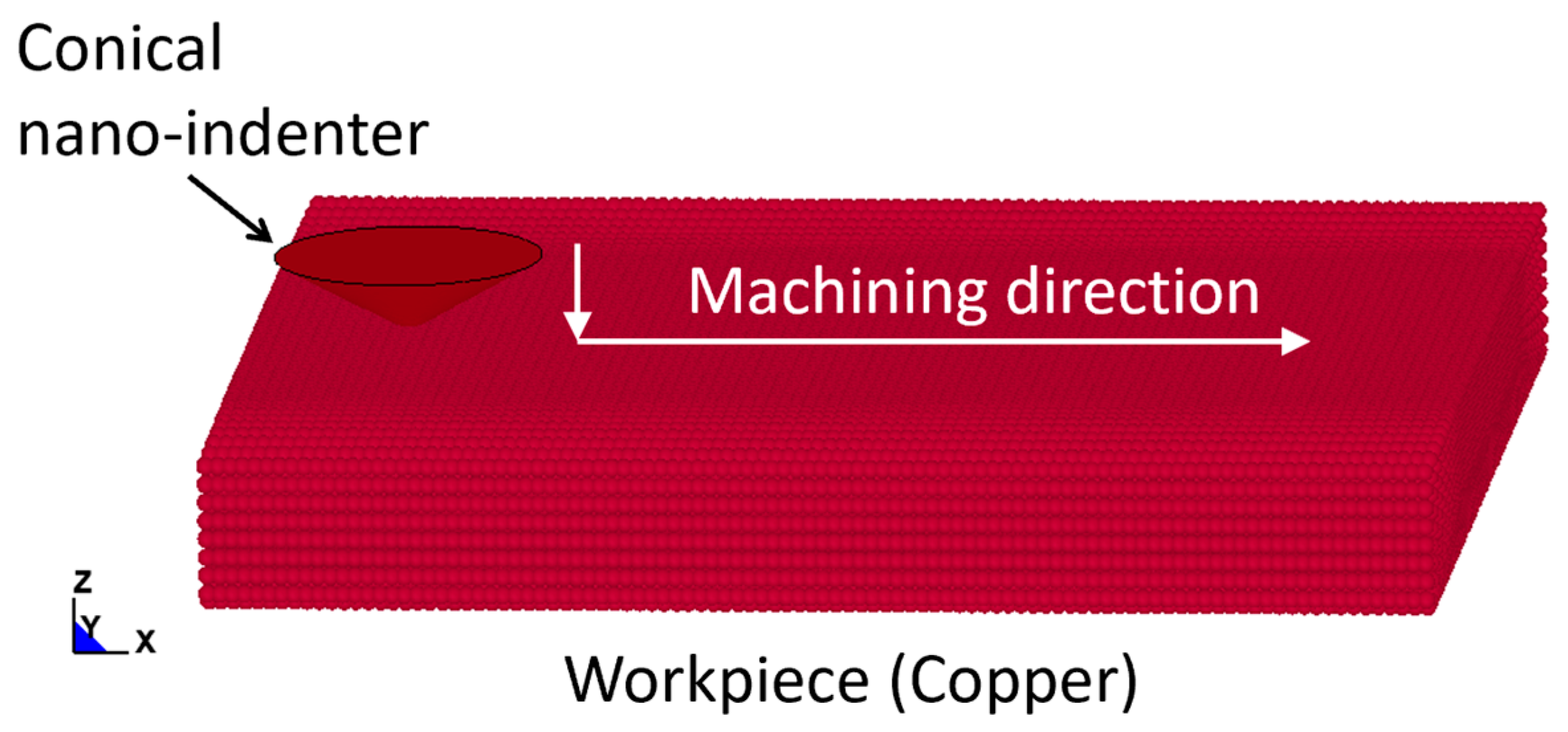
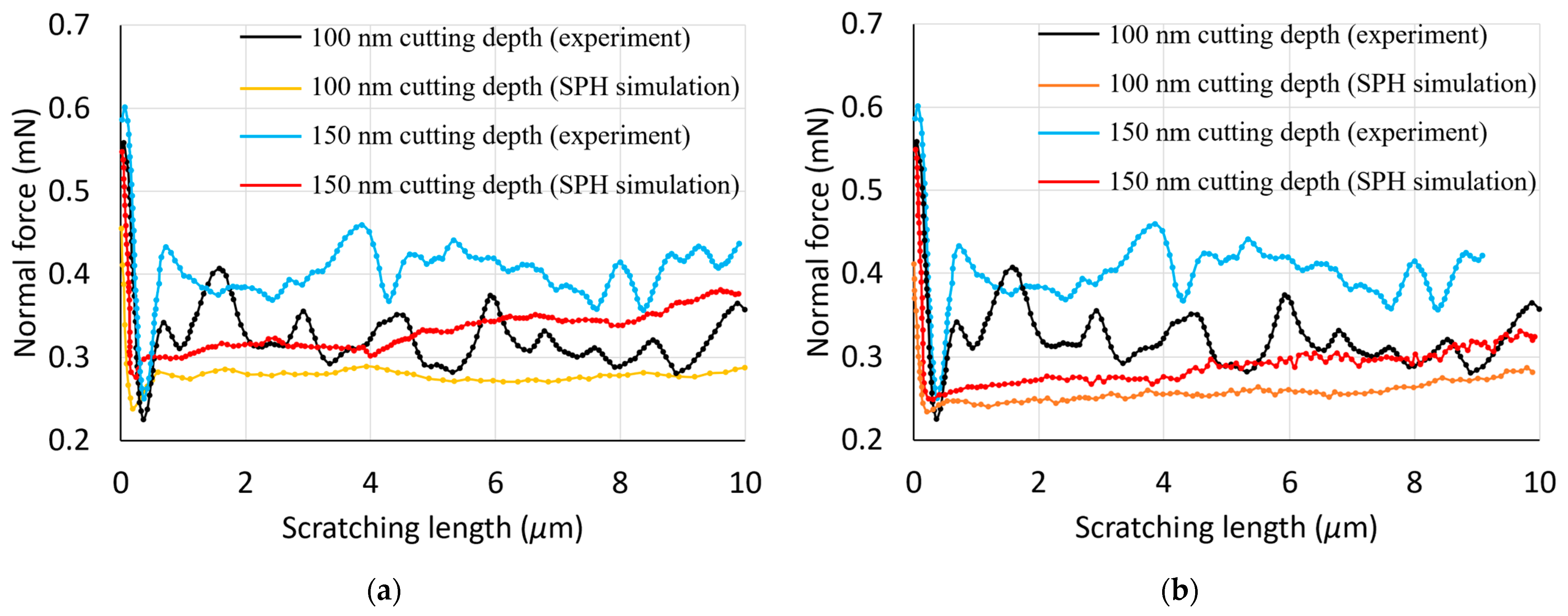
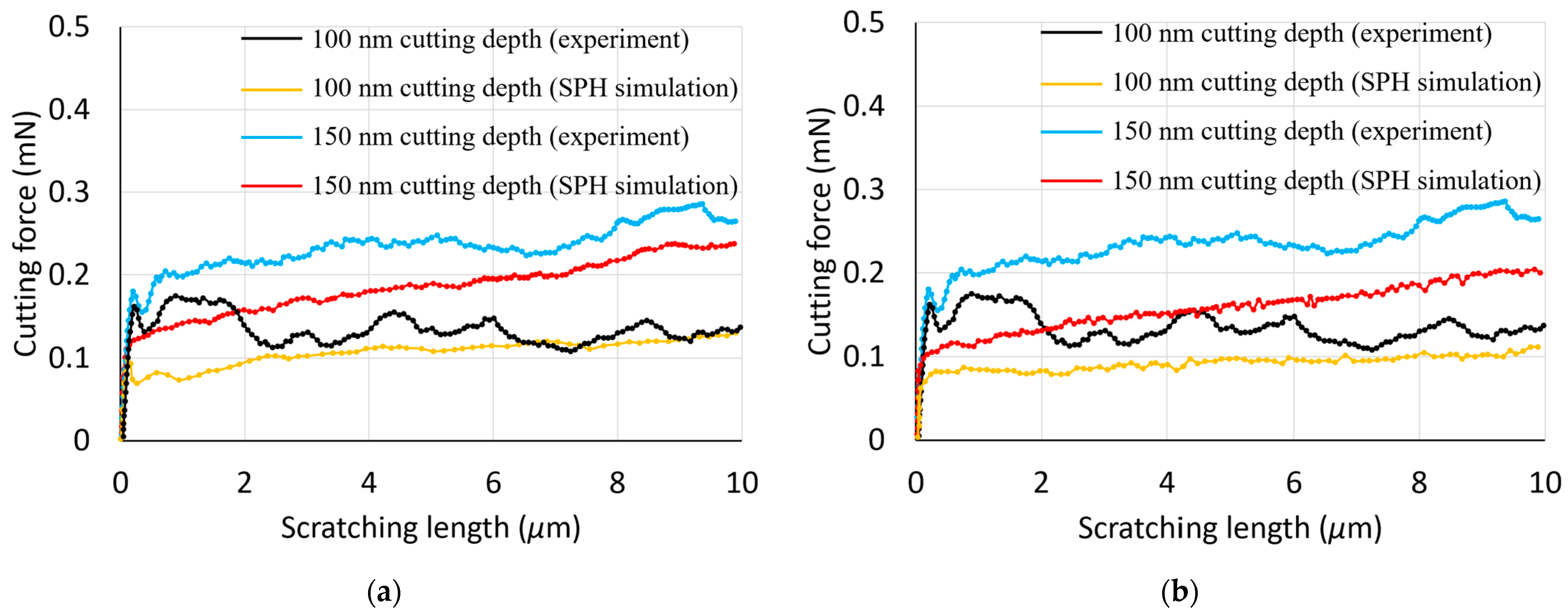


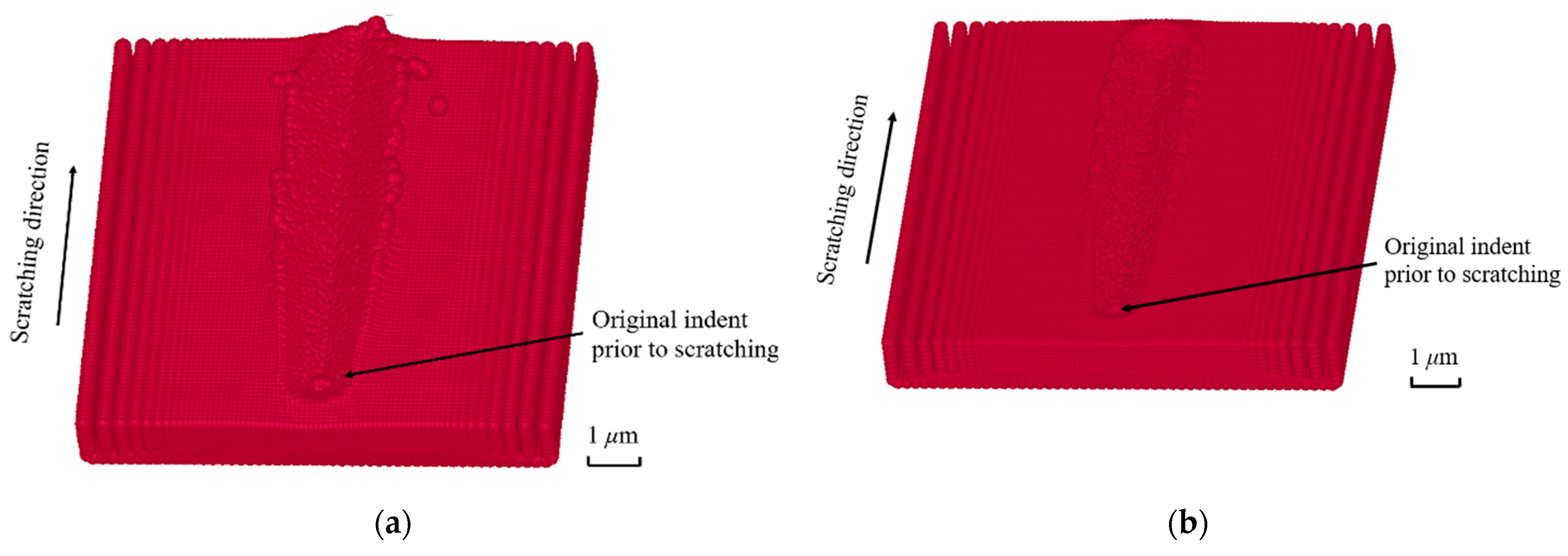

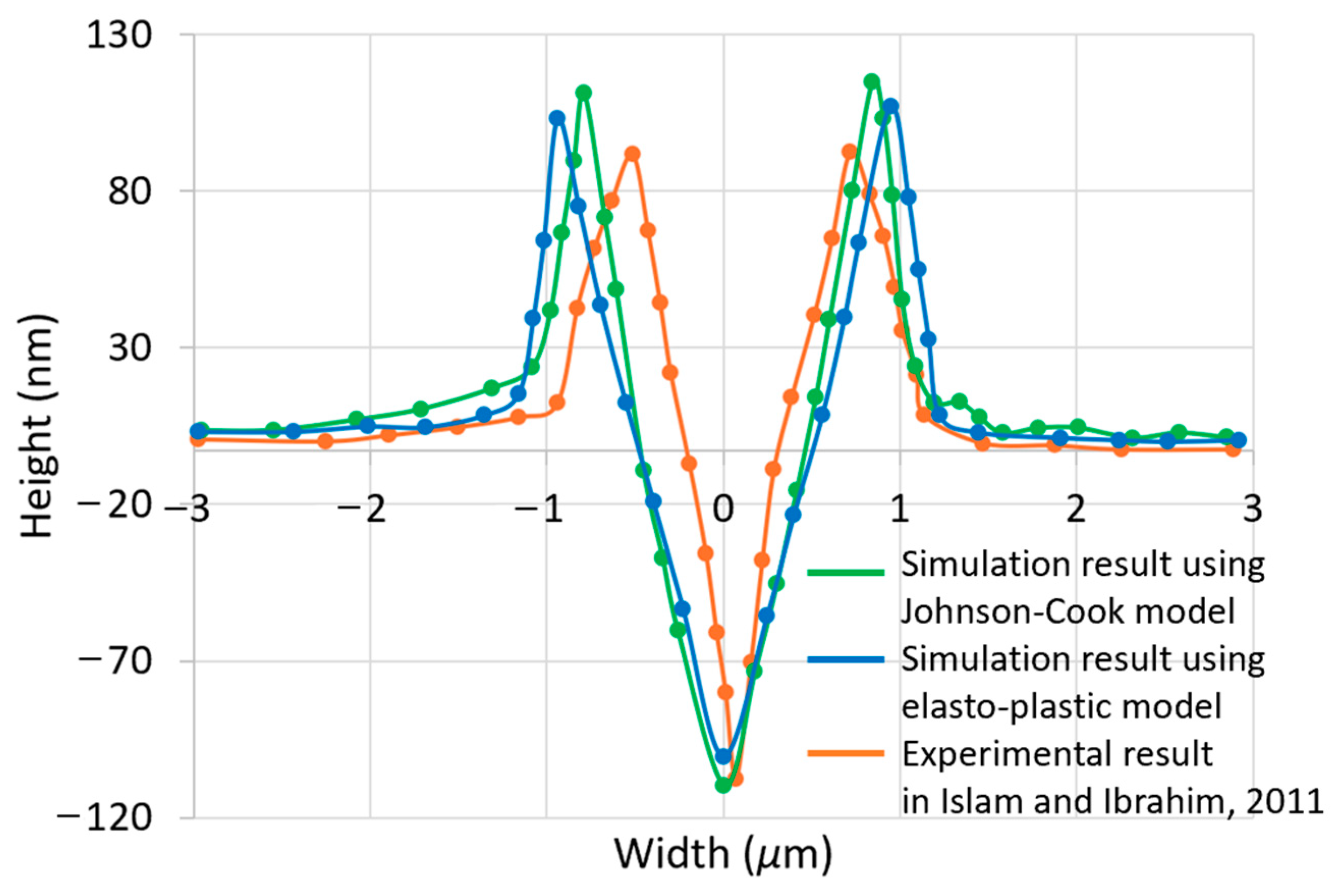
| Parameters | Value | Reference |
|---|---|---|
| Density (ρ) | 8.93 g/cm3 | |
| Young’s modulus (E) | 117 GPa | |
| Poisson’s ratio (ν) | 0.30 | |
| A | 0.09 GPa | [8] |
| B | 0.292 GPa | [8] |
| C | 0.025 | [8] |
| m | 1.09 | [8] |
| n | 0.31 | [8] |
| Tm | 1356 K | [8] |
| T0 | 293 K | [8] |
| Parameters | Value |
|---|---|
| Density (ρ) | 8.93 g/cm3 |
| Young’s modulus (E) | 117 GPa |
| Poisson’s ratio (ν) | 0.30 |
| Tangent modulus | 43 GPa |
| Yield stress | 360 GPa |
| Scratch Distance (μm) | Johnson–Cook Model | Elasto-Plastic Model | ||
|---|---|---|---|---|
| Scratch Depth (nm) | Scratch width (μm) | Scratch Depth (nm) | Scratch Width (μm) | |
| 2 | 109 | 1.32 | 98 | 1.56 |
| 3 | 117 | 1.54 | 100 | 1.82 |
| 6 | 115 | 1.66 | 103 | 1.88 |
| 8 | 116 | 1.68 | 100 | 1.89 |
| Averaged value | 114 | 1.55 | 100 | 1.79 |
| Experimental dimensions | 112 | 1.24 | 112 | 1.24 |
| Percentage difference | 2% | 25% | 11% | 44% |
Disclaimer/Publisher’s Note: The statements, opinions and data contained in all publications are solely those of the individual author(s) and contributor(s) and not of MDPI and/or the editor(s). MDPI and/or the editor(s) disclaim responsibility for any injury to people or property resulting from any ideas, methods, instructions or products referred to in the content. |
© 2024 by the authors. Licensee MDPI, Basel, Switzerland. This article is an open access article distributed under the terms and conditions of the Creative Commons Attribution (CC BY) license (https://creativecommons.org/licenses/by/4.0/).
Share and Cite
Shen, H.; Kulasegaram, S.; Brousseau, E. On the Aptness of Material Constitutive Models for Simulating Nano-Scratching Processes. Materials 2024, 17, 4208. https://doi.org/10.3390/ma17174208
Shen H, Kulasegaram S, Brousseau E. On the Aptness of Material Constitutive Models for Simulating Nano-Scratching Processes. Materials. 2024; 17(17):4208. https://doi.org/10.3390/ma17174208
Chicago/Turabian StyleShen, Hao, Sivakumar Kulasegaram, and Emmanuel Brousseau. 2024. "On the Aptness of Material Constitutive Models for Simulating Nano-Scratching Processes" Materials 17, no. 17: 4208. https://doi.org/10.3390/ma17174208
APA StyleShen, H., Kulasegaram, S., & Brousseau, E. (2024). On the Aptness of Material Constitutive Models for Simulating Nano-Scratching Processes. Materials, 17(17), 4208. https://doi.org/10.3390/ma17174208







